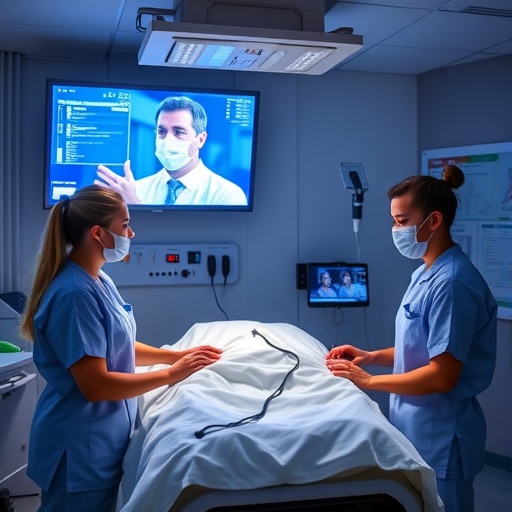In recent years, the integration of technology into healthcare education has taken on new dimensions, particularly in nursing. A groundbreaking study emerging from a collaborative effort by Alharbi, Almagharbeh, Alfanash, and their colleagues examines the perceptions surrounding Holopatient technology. This innovative educational tool mimics real patient interactions, offering nursing students a safe yet effective way to develop their clinical skills. In a world where patient simulation becomes increasingly vital, understanding both student and faculty perspectives can illuminate the path toward more effective technology integration in nursing curricula.
Holopatient technology utilizes high-definition holographic projections to deliver realistic patient scenarios. These scenarios are designed to simulate a variety of patient conditions, allowing students to interact with a holographic representation of a patient while practicing their communication skills, diagnosis, and treatment plans. This technology is particularly relevant in a nursing context, where hands-on experience and empathetic patient engagement play pivotal roles. The ability to practice these skills in a controlled environment can increase student confidence and preparedness prior to entering real-world healthcare settings.
The cross-sectional analysis conducted by the researchers encompassed a diverse range of participants, including current nursing students and faculty members. Through interviews and questionnaires, the study delved into how these groups perceive the effectiveness and applicability of the Holopatient technology within their training. The findings indicate a general enthusiasm for the technology among students. Many reported feeling that the interactive component provided an engaging learning experience that traditional methods could not match. The immersive nature of Holopatient technology appears to captivate students and instill a profound understanding of patient care.
However, the study also unveiled contrasting perceptions among faculty members. While many educators recognized the potential benefits of Holopatient technology in fostering student engagement, some expressed concerns regarding the logistics of implementing such advanced technologies in their curricula. Questions surrounding training for faculty, financial implications, and the need for additional resources were raised. Thus, while students may readily adapt to new technologies, faculty may require further support to ensure an effective teaching environment.
Moreover, one of the significant advantages of Holopatient technology is its scalability. Unlike mannequins or traditional simulation rooms, this technology can be accessed remotely, allowing nursing programs that may lack sophisticated facilities to utilize it effectively. The potential to reach students across various geographical locations implies a more inclusive approach to nursing education. This could be particularly transformative for institutions in underserved communities or those faced with resource constraints, ultimately diversifying the nurse workforce.
The implications of the findings also stretch beyond just the technical aspects of Holopatient technology. The study highlights a necessity for ongoing dialogue between students and faculty when integrating innovative tech solutions. Establishing productive communication can bridge gaps in understanding and facilitate a smoother transition into technologically enhanced teaching methodologies. Such collaborations can further empower faculty members, giving them a sense of partnership with students in the pursuit of quality education.
Furthermore, addressing the differences in perceptions about technology adoption can lead to a more cohesive educational approach. Continuous feedback loops will help in refining how Holopatient technology is presented and utilized within nursing education. This adaptability aligns well with the evolving landscape of healthcare, where novel challenges necessitate that both students and educators remain agile and responsive.
In light of their findings, the authors propose that educational institutions not only invest in advanced technologies like Holopatient but also provide adequate professional development opportunities for faculty. This dual approach ensures that technology is not just presented as an isolated novelty, but rather as part of a comprehensive educational framework designed to enhance nursing skills and readiness to tackle real-world challenges.
As the research unfolds, it paints a promising picture of technology’s role in shaping the future of nursing education. Holopatient technology stands to make a significant impact, potentially revolutionizing how new generations of nurses are trained. Through careful implementation and alignment between student experiences and faculty support, the promise of this technology can be fully realized.
The study also mentions the importance of continual assessment of educational outcomes associated with Holopatient technology. Nursing educational authorities should consider developing specific metrics to evaluate how this technology affects learning and patient interaction competencies. Such assessments will provide critical data on efficacy and allow for further refinements, contributing to an ongoing cycle of improvement in curriculum design.
In conclusion, Alharbi et al.’s research underscores the transformative potential of Holopatient technology in nursing education while also illuminating challenges that must be navigated. It sheds light on the complex relationship between student engagement, educational technology, and faculty readiness. Moving forward, collaborative action will be critical in harnessing this technology’s full potential, ensuring that nursing students not only learn but thrive in an increasingly complex healthcare environment.
As the demand for nursing professionals continues to soar, fostering an educational landscape that embraces holistic approaches technology offers could yield substantial benefits. Engaging with this research provides education stakeholders insights into paving a more effective path for nursing education, one where technology and pedagogy complement each other harmoniously.
Establishing a feedback-rich environment around technologies like Holopatient can ultimately foster innovation, driving further advancements in nursing education and enhancing future patient care.
Subject of Research: Holopatient technology in nursing education and its perceptions among students and faculty.
Article Title: Holopatient technology in nursing education: a cross-sectional analysis of student and faculty perceptions.
Article References:
Alharbi, A., Almagharbeh, W., Alfanash, H. et al. Holopatient technology in nursing education: a cross-sectional analysis of student and faculty perceptions.
BMC Nurs 24, 1192 (2025). https://doi.org/10.1186/s12912-025-03856-6
Image Credits: AI Generated
DOI: 10.1186/s12912-025-03856-6
Keywords: Holopatient technology, nursing education, student perceptions, faculty perceptions, healthcare technology.




